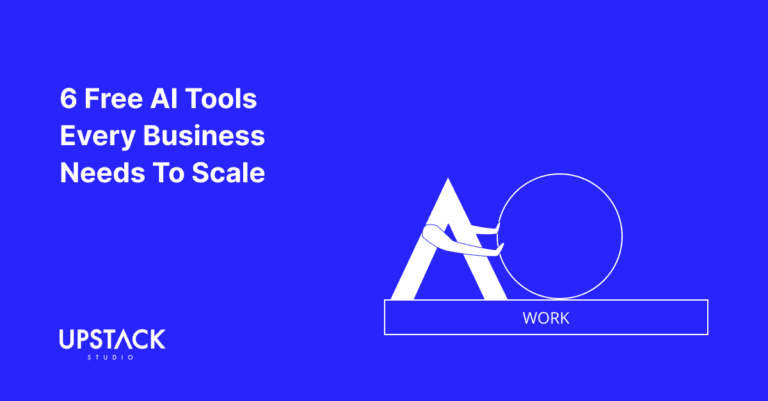Remember AI’s Core Purpose
AI or Artificial Intelligence, at its heart, is the concept of creating machines that can mimic human cognitive functions.

Systems with AI capabilities learn from experiences and adjust to new inputs, and even improve performance over time without being explicitly programmed to.
And as global website visits to ChatGPT stood at 1.43 billion in August 2023, founders out there may be interested to learn whether they can build their own AI model.
The answer is a tentative yes, and this post shows you how.
Machine Learning vs. Artificial Intelligence
We’ve heard these terms used interchangeably, but they aren’t exactly the same.
While both Machine Learning (ML) and AI are related, they represent different aspects in the broad spectrum of intelligent computation.
A summary before we begin: ML is a subset of AI.
Machine Learning
- Machine learning is a subset of artificial intelligence that focuses on the development of algorithms and statistical models that enable computers to perform tasks without explicit instructions, relying on patterns and inference instead.
- ML algorithms learn from data. They are trained on a dataset to recognize patterns, make predictions, or perform specific tasks.
- ML algorithms can be broadly categorized into three types: supervised learning, unsupervised learning, and reinforcement learning.
Artificial Intelligence
- Artificial intelligence is a broader concept that encompasses machines or systems that can perform tasks that typically require human intelligence. This includes learning, reasoning, problem-solving, perception, understanding natural language, and interacting with the environment.
- AI can be achieved through various techniques including machine learning, but also encompasses other approaches such as expert systems, knowledge representation, and symbolic reasoning.
A 7-Step AI Software Product Roadmap
Building an AI system may seem impossible, but break it down into digestible steps and it’s no longer impossible – just really really hard!
Here are the seven steps:
- Identify Business Problems and Define Project Goals
- Perform Data Collection and Cleaning
- Select Tools and Frameworks
- Building and Training the AI Model
- Testing and Evaluating the AI
- Deployment and Integration
- Continuous Monitoring and Update of the Model
Let’s walk through them.
1. Identify Business Problems and Define Project Goals
Begin by identifying your business challenges and goals that AI can address.
Are you trying to improve key business processes like customer service or accounting?
Or solve a mundane task like passing the butter?

Once the problem is identified, set clear goals for what you aim to achieve with your AI system.
2. Perform Data Collection and Cleaning
A successful AI project is heavily reliant on high-quality, relevant data.
You wouldn’t want your AI learning from faulty data – imagine not being able to trust anything it says!
So begin by collecting data that your AI system can learn from.
Then comes cleaning—removal of irrelevant data, fixing errors and inconsistencies, ensuring your data set is clean and accurate.
3. Selecting AI Tools and Frameworks
Selecting the right set of tools and frameworks can create a future-proof technology stack for your AI system.
Each component serves a distinct purpose, catering to the diverse requirements of various AI subdomains.
Here’s an overview of key tools and frameworks across different categories:
- Machine Learning: Powers AI applications by enabling systems to learn from data and make autonomous decisions. Libraries like TensorFlow, PyTorch, and scikit-learn offer algorithms for tasks like classification, regression, and clustering.
- Natural Language Processing (NLP): Facilitates language understanding and generation using frameworks like NLTK, spaCy, and Hugging Face’s Transformers. These tools support text classification, sentiment analysis, and language translation.
- Robotics: Enables the development of intelligent systems with frameworks like ROS, facilitating tasks such as sensor integration, motion planning, and control for various robotic applications.
- Other AI Subdomains: Include computer vision tools like OpenCV and TensorFlow Object Detection API, reinforcement learning platforms like OpenAI Gym, and domain-specific libraries for tasks like audio processing and recommendation systems
From open-source ecosystems like TensorFlow and PyTorch to cloud-based platforms such as Cloud ML Engine and Amazon SageMaker, developers have a plethora of options to choose from when assembling their AI technology stack.
By carefully evaluating the features, performance, scalability, and community support of each tool or framework, organizations can build a future-proof infrastructure that empowers them to tackle complex AI challenges and drive innovation in their respective domains.
Once your tech stack is ready, it’s time to start building.
4. Building and Training the AI Model
Building an AI model involves using machine learning algorithms to train the system to recognize patterns, make predictions, or complete tasks.
Model training involves running your model on your dataset and adjusting the parameters, thus refining your model.
As mentioned above, three types of training can be used.
Supervised Learning
Common use case: image classification, spam detection, and regression analysis
In supervised learning, the model is trained on a labeled dataset, where each input data point is associated with a target label. The goal is to learn a mapping from input variables to output variables based on example input-output pairs. Algorithms adjust parameters during training to minimize the difference between predictions and actual target values.
Unsupervised Learning
Common use case: clustering, anomaly detection, and dimensionality reduction
Unsupervised learning involves training models on unlabeled data. The goal is to find patterns or structures in the data without explicit guidance. Algorithms attempt to learn the underlying structure, such as clustering similar data points or discovering hidden patterns or associations.
Reinforcement Learning
Common use case: game playing, robotic control, and recommendation systems
Reinforcement learning is about an agent learning to make decisions by interacting with an environment. The agent learns through trial and error, receiving feedback in the form of rewards or penalties based on its actions. The goal is to learn a policy that maximizes cumulative rewards over time.
5. Testing and Evaluating the AI Model
Next, put your AI system through rigorous testing to ensure that it performs as intended.
It’s like a spell check for your AI software, spotting errors and refining further.

Of course, the steps below are a bit more complicated than your average spell check!
- Data Splitting: Divide the dataset into training, validation, and testing sets to separate data for training, tuning hyperparameters, and final evaluation.
- Performance Metrics Selection: Choose appropriate evaluation metrics based on the task, such as accuracy, precision, recall, F1 score for classification, or MSE, RMSE, MAE for regression.
- Evaluation on Validation Set: Periodically assess the model’s performance on the validation set during training to monitor for overfitting or underfitting and adjust hyperparameters accordingly.
- Final Evaluation on Testing Set: Assess the model’s performance on the testing set after training completion to obtain an unbiased estimate of its generalization performance on unseen data.
- Cross-Validation (Optional): Implement k-fold cross-validation if the dataset is small to ensure robustness of performance evaluation by training and testing the model on different data subsets.
- Analysis of Errors: Analyze the errors made by the model on the testing set to identify patterns or common failure modes and gain insights for further improvement or data collection.
- Benchmarking Against Baselines: Compare the model’s performance against baseline models or existing solutions to assess its relative effectiveness and identify areas for further optimization.
- Real-World Testing (Optional): Deploy the model in a production environment for real-world testing, monitoring its performance over time, gathering user feedback, and refining as needed for practical use.
Once satisfied with your AI’s performance, integrate it into your existing systems or processes.
6. Deployment and Integration
It’s just like adding a new player to your team – carefully integrating their capabilities with the rest of the team for achieving common goals.
In practice, it will look a bit like this:
- Model Export: Prepare the trained AI model for deployment. This involves packaging the model along with any necessary dependencies and configurations into a format suitable for deployment.
- Infrastructure Setup: Establish the necessary infrastructure for hosting the model.This might involve provisioning cloud resources, setting up servers or containers, and configuring networking and storage solutions.
- API Development (Optional): Create an API for accessing the model remotely. APIs abstract away the complexity of interacting with the model directly, providing a standardized interface for communication.
- Model Deployment: Deploy the model to the chosen infrastructure. This typically involves deploying the model files to a server or cloud service and configuring them to accept and process incoming requests.
- Testing: Thoroughly test the deployed model for performance and reliability. This includes evaluating the model’s accuracy, latency, throughput, and robustness under different conditions and input scenarios.
- Integration: Integrate the model into existing systems or processes. This may involve modifying existing workflows, applications, or interfaces to incorporate the model’s predictions or insights seamlessly.
- Monitoring and Maintenance: Implement monitoring and regular maintenance routines. Set up monitoring tools and alerts to track key metrics like model accuracy, resource utilization, and request latency.
- Security Measures: Ensure security measures are in place to protect the model and sensitive data it may handle. Implement authentication, authorization, and encryption mechanisms to control access to the model and safeguard against unauthorized usage or data breaches.
- Documentation and Training: Provide documentation and training materials for users to understand. Document key aspects such as model architecture, input/output formats, API endpoints, usage examples, and troubleshooting guidelines.
This applies regardless of whether the AI model is for your own use or to be sold to external users.
7. Monitoring and Updating Model
Like any other technology, AI too needs regular maintenance.
This involves monitoring the performance, identifying issues, and making prompt updates.
It’s just like servicing your car – keeps it running smoothly on the road instead of crashing every five seconds!
Tying Everything Together: Embracing AI as a Journey of Innovation and Growth
Crafting an AI software system may have its challenges, but by taking a systematic approach, it becomes a rewarding journey of creativity, problem-solving, and continuous enhancement.

Remember every AI project is unique and may require a touch of adaptation of this process.
So, ready to embrace AI and ride the digital wave?
As organizations embark on their AI journey, they step into a world of boundless possibilities and transformative potential.
By harnessing the power of AI technologies, they can unlock new opportunities, streamline operations, and drive innovation across industries.
Hey there stranger, thanks for reading all the way to the end. Consider joining our mailing list for a one-stop resource on everything from micro SaaS validation all the way to execution and promotion. Get a nifty list of questions to ask app developers when you sign up!
Download this template now so you know exactly what to ask App Development Agencies! Let us know where should we send it through the form below.








